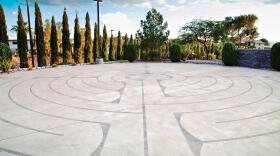As a wildlife biologist and photographer, Sharon K. Schafer fulfilled a dream when she visited the Galapagos Islands in 2004. She hoped that while she was there, she’d see Darwin’s finches, a group of about 15 bird species that vary slightly from island to island, which helped Charles Darwin to develop his theory of natural selection.
“As I walked up to the visitors center, I saw one, and I was so excited,” Schafer recalls. “I took out my camera and held it up to take a picture, but I couldn’t find it. I thought it must have flown away.” Lowering the camera, she found she was wrong: The finch was perched on the end of her lens. Such luck — more than patience or determination — has helped Schafer capture the Mojave Desert animals that she focuses on in her current work. “And you have to move quietly through the landscape,” she says. “If anything, I try to be aware, and it seems like no matter where you go, something is happening.”
What’s happening in Schafer’s forthcoming book, Becoming Animal: Standing Witness for the Sentient Wild, isn’t all majesty. There’s a tinge of menace around the edges, too. In one set of images, a pair of desert bighorn sheep nuzzle each other, their curved horns intertwined against a bleak white background. The artist intended to show that humans have the power to erase an animal’s natural habitat. For another photo, “Requiem for the Blues,” Schafer pinned eight Mount Charleston blue butterflies (an endangered species) to a sheet of music: arrested movement.
The book stemmed from a show of Schafer’s photography that began in the fall of 2015 at the Nevada State Museum in Las Vegas and is currently at the National Conservation Training Center in West Virginia. Schafer uses the show, which travels to Tucson next, as an activism opportunity.
“I figured if I could show people the beauty of the wildlife, they’d feel connected to it, and that would lead to a desire to conserve it,” she says. “But I realized, after that first show, that without a distinct call to action, people just walked away thinking, ‘Isn’t that beautiful?’ If anything, I gave them the feeling that things were okay in the wild lands.”
So the former BLM wildlife biologist took a more direct approach. She added to the show a collection of 5-by-7 images in plastic frames that visitors could take home with them. In exchange for the gift, Schafer asked for a promise: something specific they’d do to be better stewards of the environment.
“We’ve gotten about 600 pledges a month, and the show was up for eight months,” she says.
Schafer learned her way of looking at and engaging with the natural world growing up in Southern California. Her mom and dad, an English and biology teacher, respectively, took the family to Death Valley at Thanksgiving, and there was always a pair of binoculars laying around the house so that “if some weird bird came flying through the backyard, we’d have them at hand,” Schafer says.
Her education background also permeates her work. Recently, an ashram in Rajastan, India, invited her to spend several weeks taking photos for brochures. The trip blossomed into a cross-continental connection between two groups of children, one in the ashram’s village, Panchla Siddha, and the other in Las Vegas. Each took pictures of their local landscapes, plants and animals and sent them to the other, so they could compare the two deserts. A photomural currently on display at the Nevada State Museum summarizes the project.
“It just happened spontaneously,” Schafer says. “I had the opportunity to go, and once I was there, I realized it was too good to not share.”









